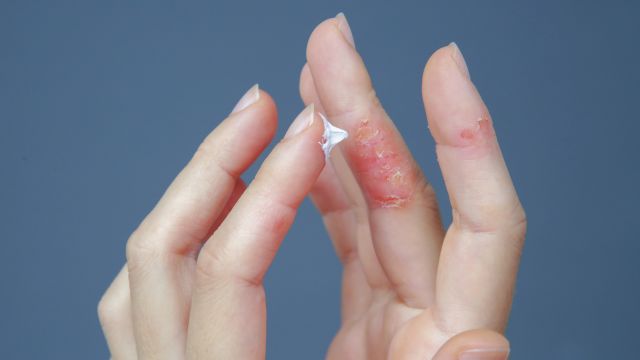Atopic dermatitis (AD) is the most common type of eczema—so common that it is sometimes used synonymously with eczema. The most recognizable symptoms are itch and patches of dry skin, and it’s sometimes called “the itch that rashes.” While it is categorized as a skin disorder, AD is a complex condition that begins in the immune system, and its causes are not fully understood.
Here, we’ll take a look at what we know about what’s happening in the skin when a person has atopic dermatitis, and a few different ways to think about AD.
An allergic condition
The “atopic” in AD refers to “atopy.” This word is defined as a genetic predisposition toward allergic conditions, including asthma, nasal allergies, and eczema. These are primarily allergic conditions. When a person has an allergic condition, the immune system overreacts to certain substances (called triggers). In the case of AD, this overreaction results in itching and dry skin.
In many cases, triggers can be difficult to identify, and symptoms can flare without any obvious cause. This can lead to a great deal of frustration when trying to get symptoms under control.
A disease of the immune system
As mentioned above, AD symptoms occur when the body’s immune system overreacts to something—certain foods, an infection, a change in weather are all potential AD triggers. When this overreaction occurs, the body sends immune cells to the skin. These immune cells damage the skin barrier and cause inflammation, which leads to dry, itchy skin.
An inflammatory disorder
Under normal circumstances, inflammation is the body’s natural reaction to injuries and infections. When cells are damaged or become infected, the body floods the area with immune cells that break down and dispose of the damaged or infected cells. This allows the body to heal and new cells to form. With AD, the inflammation impacts cells in the skin that would otherwise be left alone.
Inflammation is a complex process that involves the interaction of different cells and pathways—some that jumpstart inflammation when it’s needed, others that keep inflammation in check when it’s not needed. While the exact cause of AD is unknown, research suggest that it occurs when some part of this complex process is not functioning normally.
Many medications used to treat atopic dermatitis work by disrupting different inflammatory or immune processes. Some are applied directly to the skin, while others are taken as pills or given as injections.
A treatable condition
There is no cure for AD, but there are treatments that can help reduce and control symptoms. The goal of treatment is for the skin to be as clear as possible. Treatment will vary from person to person, but everyone with AD will need to focus on identifying and avoiding triggers, following a skincare routine, and keeping the skin moisturized. Many people will also require additional therapies, such as medications or phototherapy.
Treatment for mild AD may be overseen by a primary healthcare provider, but people with more moderate or severe symptoms—or symptoms that are difficult to control—are often advised to work with a dermatologist. A dermatologist is a medical doctor that specializes in the treatment of conditions that affect the skin.
One aspect of your overall health
AD can feel all-encompassing at times, especially when symptoms are flaring. But it’s important to remember the other aspects of your health, both physical and mental. Eating a balanced and nutritious diet, being physically active, and getting enough sleep should also be priorities. It’s also important to quit and avoid unhealthy habits, like smoking or consuming too much alcohol. Healthy habits can have a positive impact on AD management as well as your overall health.
Mental and emotional health also need to be a priority. Living with AD is not easy—frustration, anger, stress, anxiety, sadness, and many other unwanted emotions are often part of the experience. Make a point to discuss your moods, emotions, and social wellbeing with your healthcare provider. Find ways to reduce stress, which can exacerbate symptoms of AD. Take a break from thinking about AD by scheduling time for something you enjoy.






